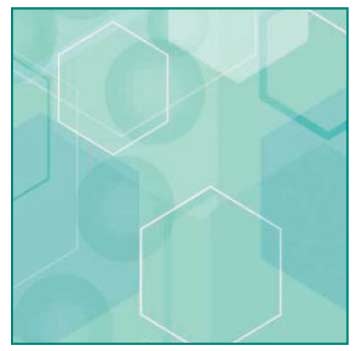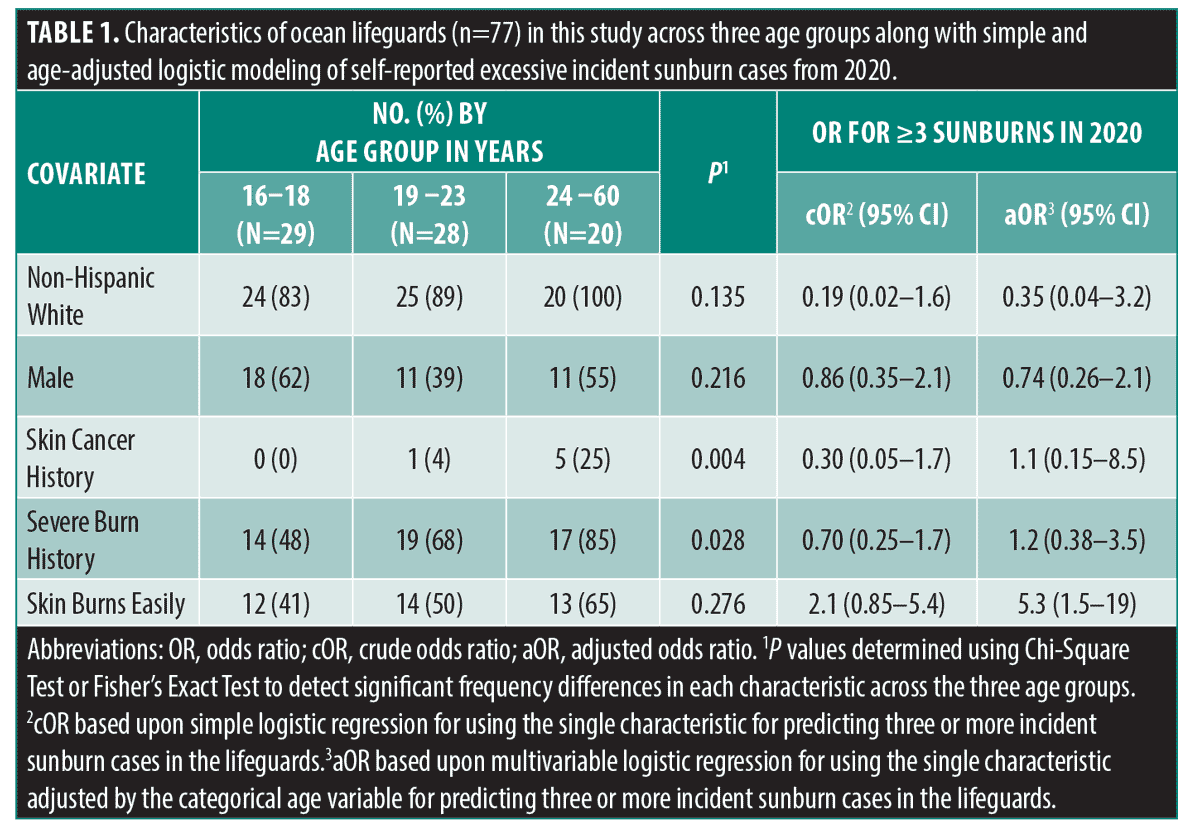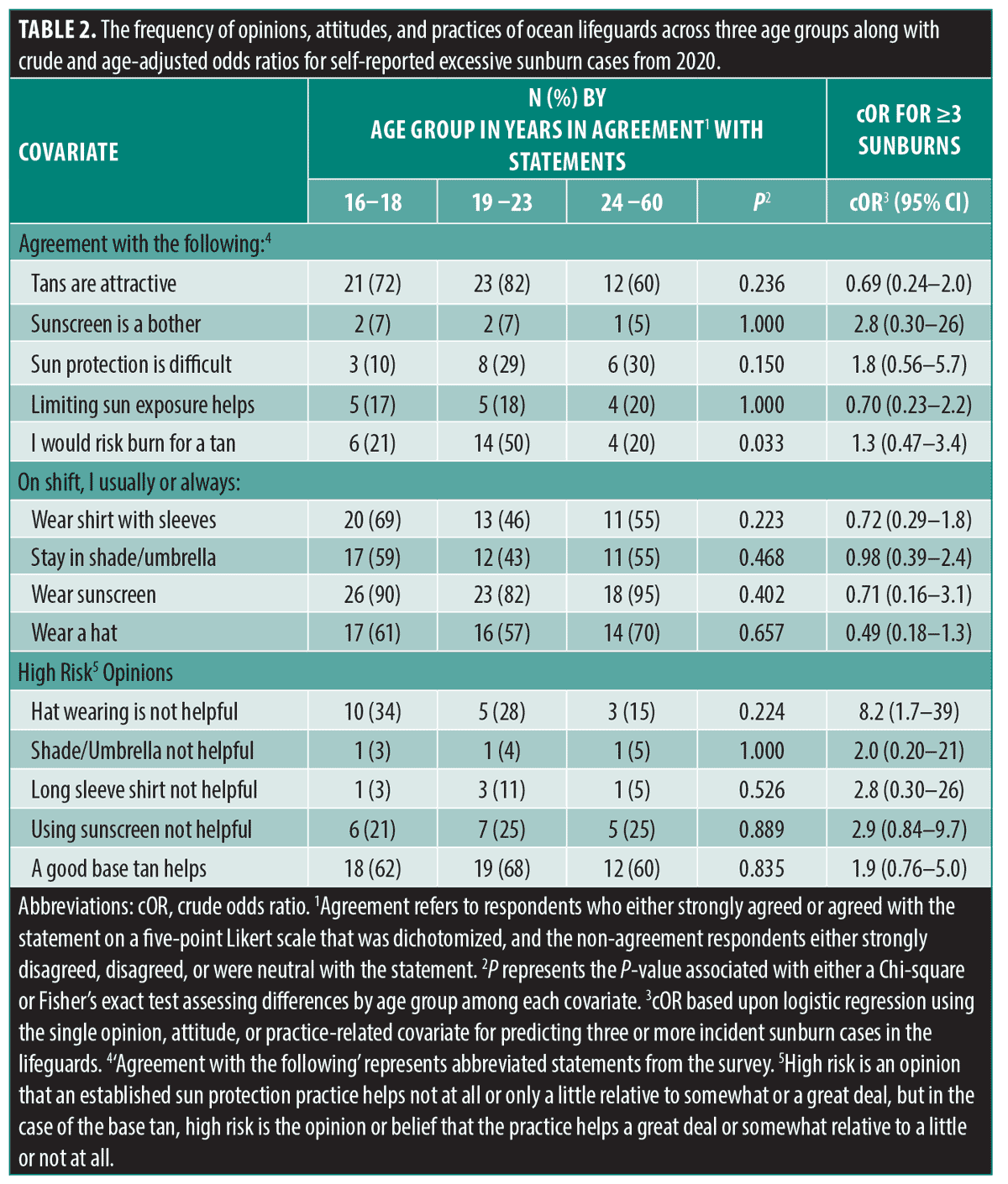 J Clin Aesthet Dermatol. 2023;16(6):46–49.
J Clin Aesthet Dermatol. 2023;16(6):46–49.
by Samuel A. Hayworth, MPH; D. Gary Brown, DrPH; and Jason W. Marion, PhD
Mr. Hayworth is with the Doctor of Osteopathic Medicine Degree Program, and the Lake Erie College of Osteopathic Medicine in Bradenton, Florida. Drs. Brown and Marion are with the Department of Environmental Health Science at Eastern Kentucky University in Richmond, Kentucky.
FUNDING: This study was supported by a university-funded faculty scholarship award from the Office of Sponsored Programs at Eastern Kentucky University.
DISCLOSURES: Dr. Brown reported receiving support from the Central Appalachian Regional Education and Research Center from CDC/NIOSH as Director of the Industrial Hygiene Core. Mr. Hayworth and Dr. Marion report no conflicts of interest relevant to the content of this article.
ABSTRACT: Objective. Research exists examining sunburn risks, sun protective behaviors, and interventions among pool lifeguards; however, ocean lifeguard research is limited. This study aimed to determine sunburn prevalence and associations between sunburn with photoprotective attitudes and habits among Florida ocean lifeguards.
Methods. A cross-sectional study was electronically administered in 2021 to ocean lifeguards using sun protection questions. Recruitment occurred through three lifeguard agencies. The frequency of self-reported sunburns from the prior season and the opinions and practices related to photoprotection and tanning were obtained.
Results. Complete data were obtained from 77 (37%) of 207 lifeguards who served during the 2020 swimming season (mean [SD] age, 22.9 [8.31] years; 40 male (52.0%) and 37 female (48.0%)). Sunburn was common with only four (5.2%) lifeguards reporting no sunburn. In total, 26 (33.8%) reported five or more sunburns. The median sunburn frequency was three. Reporting three or more sunburns was positively associated with being a teenager (16 to 18 years) (aOR: 14.9, 95% CI 3.5 to 64.2) or young adult (19 to 23 years) (aOR: 6.4, 95% CI 1.6 to 25.2) and having a neutral opinion regarding sunscreen effectiveness (aOR: 4.5, 95% CI 1.1 to 18.7) in logistic regression models.
Limitations. Self-reported sunburns were recalled and not clinically evaluated. Recall, participation, and social desirability biases may have been present.
Conclusion. Ocean lifeguards reported appreciably high rates of sunburn, especially younger lifeguards. Increased photoprotection education, engineering controls, and research are warranted for this occupational group.
Keywords. Sunburn, lifeguard, sun protection, ultraviolet radiation, skin cancer, occupational health, tanning, sun protective behaviors, photodermatology
Relationships between sunburn and melanoma occurrence among outdoor workers are well-established.1 While US mortality rates from melanoma have dropped substantially through improved therapies,2 180 deaths in the US from melanoma were estimated in 2021 with 106,110 incident cases.3 Additionally, interventions for non-melanoma skin cancers (NMSCs) are warranted as a “NMSC epidemic”4 afflicts over five million US persons annually.5 Furthermore, US sunburn-related medical treatment costs exceed $11 million annually.6 Accordingly, outdoor occupations have been identified as needing interventions to minimize ultraviolet radiation (UVR) exposure.7
Among populations warranting investigation, beach lifeguards have elevated skin cancer risks from high UVR doses8 and inadequate utilization of sun protection strategies.8,9 Relative to pool lifeguards, beach lifeguards are understudied. Beach lifeguards are often assigned to locations with less sun protection than pool lifeguards.10 US ocean lifeguard studies are limited to a study from the 2018 Annual National Lifeguard Championships (n=215) and a 2013 Hawaii study (n=52).9,11 Due to limited research on Atlantic Ocean lifeguards, we assessed sunburn frequency, attitudes, and practices related to sun protection among Florida ocean lifeguards during the 2020 season, which occurred early in the COVID-19 pandemic.
Methods
This retrospective cross-sectional study gathered data from ocean lifeguards using an electronic survey. Three email invitations were distributed by ocean safety supervisors to full-time and seasonal lifeguards having current or recent employment. Supervisors were from three Florida local government agencies with safety responsibilities for several of Florida’s most visited Atlantic Ocean public beaches. Survey administration via Qualtrics occurred within April and May 2021.
Assessing risk factors for frequent sunburn (≥3 burns) in the prior year (2020) was a central aim for enabling comparison with other studies9 and since having three or more sunburns has been linked to increased risks for melanoma (when occurring with blistering before 20 years of age)12, and non-melanoma skin cancer when three or more sunburns have been painful13 or blistered.14 Prior literature9 covering ocean lifeguards suggested over 30 percent of lifeguards would have had three or more burns. For exploring age-related factors and two other covariates in multivariable logit models, a total of 10 frequently burned lifeguards per independent variable was deemed minimally necessary,15 necessitating 30 frequently burned respondents. Accordingly, we aimed for more than 100 respondents.
The 50-item questionnaire was derived from the adult version of the Sun Habits Survey,16 retaining 33 of 41 items, including all of the validated self-reported sunscreen use questions in Glanz et al.16 The non-validated questionnaire used for this study differed from the Sun Habits Survey by (1) adding two opinion questions, “I would risk getting sunburned for the sake of getting a tan,” and “It is too much bother to use sunscreen,” (2) adding eight lifeguard employment history questions, (3) broadening demographic questions to provide more category options for inclusivity, and (4) removing eight questions from the sun protection knowledge section for brevity. Five-point scales assessed respondent opinions regarding tanning, tan attractiveness, and whether certain behaviors protect from the sun, including wearing sunscreen, shirts, hats, seeking shade and using an umbrella. Self-reported protective behaviors were obtained using a four-point scale (never or rarely, sometimes, usually, and always) to indicate how frequently respondents use sun protective strategies. Hair, eye, and skin color were obtained. Self-reported history of skin cancer diagnosis, severe sunburn as a child, and ease of burning after 30 minutes in sunlight were obtained. Participants responded to “How many times last summer did you get burned?” Demographic and occupation information were obtained, including years working as a lifeguard, seasonal/full-time status, and estimated hours worked per week in 2020.
Data were dichotomously coded into agree (1) and neutral/disagree (0). For personal sun protection practices, data were coded into practice (1) or do not regularly practice (0); whereby, “always” and “usually” were coded as “1” and sometimes, rarely, and never were coded as “0”. Three age terciles were created in Stata 15, and comparisons by age group were done using Chi-square tests or Fisher’s exact tests (if any cell count <5). Crude odds ratios (cOR) and adjusted odds ratios (aOR) for reporting three or more sunburns were obtained using simple and multivariable logistic regression in Stata 15, respectively.
Social desirability and participation biases were mitigated as responses were obtained anonymously and participants were offered a $10 incentive gift card in accordance with Eastern Kentucky University’s approved IRB protocol (#3864-2021).
Results
Seventy-seven complete and eight incomplete surveys were obtained from 207 lifeguards. Inaccurate addresses, email filters, and/or lack of email use and interest, contributed to the 37 percent response rate for completed surveys. Fifty-seven (74%) of the 77 respondents were under 24 years old. Among respondents, the average age was 22.9 years (SD=8.3). There were 40 male (52.0%) and 37 female (48.0%) respondents, 89.7 percent of whom were predominantly non-Hispanic white. By age group, there were no differences demonstrated (p>0.05) in race or sex (Table 1). The oldest age tercile (24–60 years) reported significantly more skin cancer and severe sunburn as children (Table 1).

Seventy-three (94.8%) lifeguards reported one or more sunburns in the 2020 season, with 46 (59.7%) reporting three or more sunburns and 26 (33.8%) reporting five or more sunburns. The mean [SD] and median sunburn frequency was 3.07 [1.65] and three, respectively. Upon age adjustment, subjects reporting their skin burns easily had 5.3-times greater odds of reporting three or more burns than those without easily burned skin.
Self-reported sunscreen use exceeded 90 percent in two of three age groups. Young adults (19–23 years) were significantly more likely to report risking a burn for a tan than others; however, persons risking a burn had no increased likelihood of reporting three or more sunburns (Table 2). Opinions that tans are attractive and base tans help for sunburn prevention were common (> 60%).

Overall, the odds of reporting three or more sunburns were over 11-times greater among 16 to18 year olds and 5.4-times greater among 19 to 23 year olds than the oldest age tercile (24 to 60 years) in the binary (cOR) and multivariable models (aOR-1 and aOR-2). In multivariable analysis, upon adjusting for age, the high-risk sunscreen opinion was associated with 4.5-times greater odds of reporting three or more sunburns (Table 3). For assessing discrimination, the area under the ROC curve (AUC) was 0.73 in the binary age category-only model, and the AUC increased to 0.78 in both multivariable models (aOR-1 and aOR-2). For assessing fit via the Hosmer-Lemeshow test, there was no difference between observed and model predicted results across six deciles of risk for the models in Table 3 reporting aOR-1 and aOR-2 (P=0.953; P=0.818, respectively).

Discussion
Among respondents, 95 percent reported one or more sunburn, and 60 percent reported three or more sunburns from a single summer season, not a lifetime. These reported frequencies are 14 percent and 28 percent greater than frequencies from a retrospective study of 215 participants at the 2018 Annual National Lifeguard Championships; whereby 81 percent self-reported one or more sunburn in the preceding 12 months, and 32 percent reported three or more burns.9 The 2018 study had an older population (mean: 34.2 versus 23 years) and included lifeguards from all US regions. Furthermore, competition participants may be not be representative of typical ocean lifeguards. Similarly, with a 37 percent response rate, the results of this Florida lifeguard study may not be representative of the Florida ocean lifeguard population.
Florida beaches in 2020 were prime destinations for tourists during and after COVID-19 stay-at-home orders from health agencies. Google searches for sunburn increased nationwide during the 2020 swimming season relative to 2016 – 2019 suggesting increased sunburn incidence.17 Additionally, 2020 sunscreen distribution data suggested decreased consumer and health agency interest in acquiring sunscreen, potentially due to pandemic-related public health fatigue.18 These factors may have impacted sunburns among lifeguards.
This study is limited by participation, recall, and self-report biases. Subjects experiencing sunburns may have had greater participation interest. Socially desirable responses on sun protective behaviors and a lack of clinic-based sunburn exams increased misclassification risks. Additionally, the absence of sunburn severity limits risk characterization for melanoma and non-melanoma skin cancer as painful and blistering sunburns are associated with increased risks.12–14 Despite limitations, the reported sunburn frequency warrants research for informing age- and lifeguard occupation-appropriate interventions.
Conclusion
Florida’s ocean lifeguards provide valuable public services including lifesaving activities. Validated and effective sun protection-related education for ocean lifeguards remain needed, particularly for teenagers and young adults. Engineering controls (sun protective guard structures) may be considered. Routine education on skin self-exams and physician consultations for determining the frequency of full-body skin examinations by board-certified dermatologists are encouraged for ocean lifeguards.
Acknowledgements
The authors are appreciative to the three public agencies and three ocean safety supervisors that supported this effort. The authors are especially grateful to the ocean lifeguards who supported this research through their participation.
References
- Ghiasvand R, Robsahm TE, Green AC, et al. Association of Phenotypic Characteristics and UV Radiation Exposure With Risk of Melanoma on Different Body Sites. JAMA Dermatol. 2019;155(1):39.
- Berk-Krauss J, Stein JA, Weber J, et al. New Systematic Therapies and Trends in Cutaneous Melanoma Deaths Among US Whites, 1986–2016. Am J Public Health. 2020;110(5):731–733.
- American Cancer Society. Cancer Facts & Figures 2021. https://www.cancer.org/content/dam/cancer-org/research/cancer-facts-and-statistics/annual-cancer-facts-and-figures/2021/cancer-facts-and-figures-2021.pdf
- Ciążyńska M, Kamińska-Winciorek G, Lange D, et al. The incidence and clinical analysis of non-melanoma skin cancer. Sci Rep. 2021;11(1):1–10.
- Rogers HW, Weinstock MA, Feldman SR, et al. Incidence estimate of nonmelanoma skin cancer (keratinocyte carcinomas) in the US population, 2012. JAMA Dermatol. 2015;151(10):1081–1086.
- Guy GP, Berkowitz Z, Watson M. Estimated cost of sunburn-associated visits to US hospital emergency departments. JAMA Dermatol. 2017;153(1):90–92.
- Schneider S, Diehl K, Schilling L, et al. Occupational UV Exposure and Sun-Protective Behaviour in German Outdoor Workers: Results of a Nationwide Study. J Occup Environ Med. 2018;60(11):961–967.
- de Troya Martín M, Sánchez NB, Harana CG, et al. Beach Lifeguards Sun Exposure and Sun Protection in Spain. Saf Health Work. Published online 2020.
- Enos CW, Rey S, Slocum J, et al. Sun-protection Behaviors Among Active Members of the United States Lifesaving Association. J Clin Aesthetic Dermatol. 2021;14(1):14.
- Diffey BL, Mobley CD. Sunburn at the seaside. Photodermatol Photoimmunol Photomed. 2018;34(5):298–301.
- Ryan KM, Breaud AH, Eliseo L, et al. Injuries and exposures among ocean safety providers: A review of workplace injuries and exposures from 2007–2012. J Occup Environ Hyg. 2017;14(7):534–539.
- Friedman RJ, Rigel D, Silverman MK, et al. Malignant melanoma in the 1990s: The continued importance of earlydetection and the role of physician examination and self-examination of theskin. CA Cancer J Clin. 1991;41(4):201–226.
- Nelson HH, Kelsey KT, Mott LA, et al. The XRCC1 Arg399Gln polymorphism, sunburn, and non-melanoma skin cancer: evidence of gene-environment interaction. Cancer Res. 2002;62(1):152–155.
- English DR, Armstrong BK, Kricker A, et al. Case-control study of sun exposure and squamous cell carcinoma of the skin. Int J Cancer. 1998;77(3):347–353.
- Peduzzi P, Concato J, Kemper E, et al. A simulation study of the number of events per variable in logistic regression analysis. J Clin Epidemiol. 1996;49(12):1373–1379.
- Glanz K, McCarty F, Nehl EJ, et al. Validity of self-reported sunscreen use by parents, children, and lifeguards. Am J Prev Med. 2009;36(1):63–69.
- Boothby-Shoemaker W, Lim HW, Kohli I, et al. Changes in Google search for “sunburn” during the COVID-19 pandemic. Photodermatol Photoimmunol Photomed. 2021 Sep; 37(5): 474–475.
- Szeto MD, Kokoska RE, Maghfour J, et al. An analysis of public sunscreen distribution in the United States during the COVID-19 pandemic. J Am Acad Dermatol. 2022;86(5):e241–e243.

